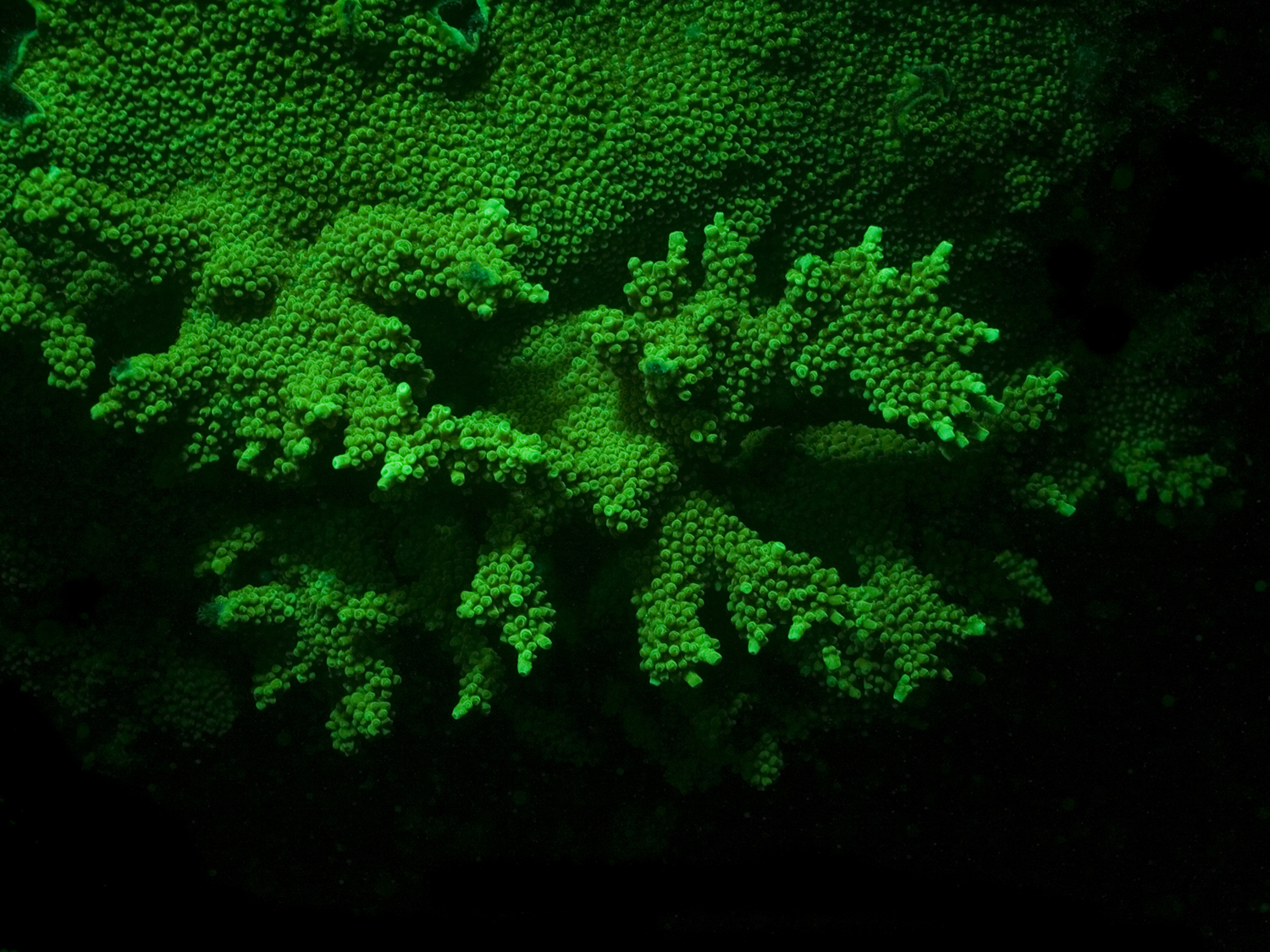A Resilient Hybrid: Fused Staghorn Coral
This hybrid coral could withstand climate change better than its relatives.

Marine biologist Colin Foord found this fused staghorn coral (Acropora prolifera) in Miami's North Biscayne Bay. The organism, photographed here at night, is expressing an abundance of green fluorescent protein, hence its verdant hue. Most staghorn and elkhorn corals (its parent species) don't exhibit this fluorescence, says Foord, "so this is another trait that makes this coral prime for in-depth study." Photo by Colin Foord/Coral Morphologic
Marine biologist Colin Foord calls the fused staghorn coral seen above “a real survivor.”
Foord first came upon a colony of the Acropora prolifera—a hybrid of staghorn (Acropora cervicornis) and elkhorn (Acropora palmata) corals—while diving around Miami’s Fisher Island in 2009. The discovery surprised him—he had seen staghorns and elkhorns before, and this coral looked somewhat similar, but it was a fluorescent green instead of brown. He soon realized that this creature was in fact a fused staghorn coral—a rare find outside of the Caribbean.
Foord, who is also the co-founder of an art and science studio in Miami called Coral Morphologic, continued to observe the organism and has found it to be especially hardy, surviving an unexpectedly cold winter for South Florida and fluctuations in ocean pollution and salinity. Foord was intrigued that the hybrid could seem so resilient, especially given that its parents are threatened under the Endangered Species Act.
Biologist Nicole Fogarty, an assistant professor at Nova Southeastern University Oceanographic Center in Dania Beach, Florida, who studied the hybrid coral for her Ph.D., says she’s been hearing about more hybrid colonies popping up around the Atlantic in just the past decade. Her own research in the Caribbean has found that the corals are in some cases fending off disease and predation better than their parental species, which could be contributing to their viability.

The hybrid doesn’t seem to be any more vulnerable to bleaching compared to its parental species, either, says Fogarty, despite the fact that they live in two to three feet of water and are exposed to higher fluctuations in temperature. “They do seem to have a higher thermal tolerance, so they can live in these really harsh environments,” she says. (In fact, Fogarty is currently in St. Thomas, experimentally testing the hypothesis that A. prolifera can survive higher temperatures.)
As corals face a multitude of threats, from climate change to disease and parasitism, Fogarty says that A. prolifera could have staying power. “People are starting to realize that in light of everything—corals worldwide declining—we actually have this one ray of hope that this hybrid’s actually doing quite well,” she says. “It seems to be a coral that might persist even with increased global temperatures.” Foord adds that, “this is a coral that has the potential for coral reef restoration.”
Propagating the fused staghorn through aquaculture in a laboratory could lead to a better understanding of why the species seems so hardy, says Foord. “[There’s] lots of research potential just into the genetics and its resilience,” he says.
But Florida’s environmental laws protect most corals from being taken—piecemeal or whole—from their natural habitat without special permissions and permits. Foord hasn’t gotten permission to take any samples of the fused staghorn growing in Miami for research, so he can only monitor the organism whenever he goes on dives.
Because it’s still the only colony he’s found so close to the shipping channel in Miami, he’s a little worried about it. Still, “I’ve seen it survive through all of these other things I was concerned about,” he says. “All I can do is hope it’s going to [continue proving] its hardiness.”
Chau Tu is an associate editor at Slate Plus. She was formerly Science Friday’s story producer/reporter.